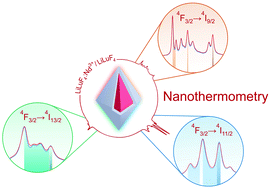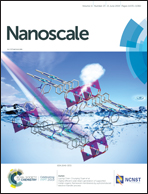Advancing neodymium single-band nanothermometry†
Abstract
Near-infrared (NIR) emitting contrast agents with integrated optical temperature sensing are highly desirable for a variety of biomedical applications, particularly when subcutaneous target visualization and measurement of its thermodynamic properties are required. To that end, the possibility of using Nd3+ doped LiLuF4 rare-earth nanoparticles (RENPs) as NIR photoluminescent nanothermometers is explored. These RENPs are relatively small, have narrow size distribution, and can easily be core/shell engineered – all combined, these features meet the requirements of biologically relevant and multifunctional nanoprobes. The LiLuF4 host allows to observe the fine Stark structure of the 4F3/2 → 4I9/2, 4I11/2, and 4I13/2 optical transitions, each of which can then be used for single-band NIR nanothermometry. The thermometric parameter defined for the most intense Nd3+ emission around 1050 nm, shows high temperature sensitivity (∼0.49% °C−1), and low temperature uncertainty (0.3 °C) as compared to the thermometric parameters defined for the 880 and 1320 nm Nd3+ emissions. Additionally, transient temperature measurements through tissue show that these RENPs can be used to assess fast temperature changes at a tissue depth of 3 mm, while slower temperature changes can be measured at even greater depths. Nd3+ doped LiLuF4 RENPs represent a significant improvement for Nd3+ based single-band photoluminescence nanothermometry, with the possibility of its integration within more sophisticated multifunctional theranostic nanostructures.



 Please wait while we load your content...
Please wait while we load your content...